Laura Perry's Blog, page 9
June 14, 2017
Book Review: p.s.Fortuna: Praises and Supplications for the Goddess
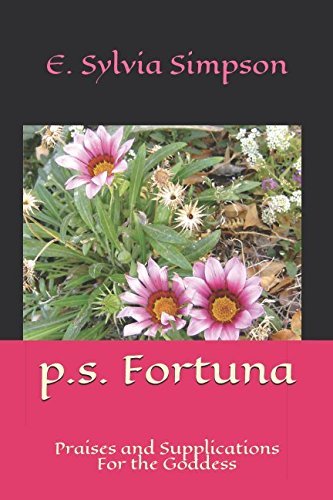 This is a very personal book about a not-so-well-known deity, the Roman goddess Fortuna. For many of us, Fortuna is more a symbol or a concept than a living goddess. But Simpson brings her to life in this book, beginning with her own relationship with Fortuna. I like that she stresses the idea of relationship. The gods aren't cosmic vending machines; you don't put in an offering and out pops a goodie. They're beings we should respect and take the time to get to know, and this book is a helpful tool in that regard. I first "met" Fortuna long ago when I studied Latin in school. She is a very approachable goddess, very willing to help as long as you respect her properly. This book is a valuable aid in that regard.I like that Simpson emphasizes Fortuna's role as the bringer of luck rather than the provider of money. This takes us right back to ancient Rome, where she was revered under dozens of different names and aspects. This book includes Fortuna's background as a Roman goddess as well as a list of her various sacred days and festivals throughout the year. But the real "meat" of this little volume is the collection of prayers to Fortuna, organized by season, each one for a different, specific purpose. There really is something for everyone, for almost every imaginable occasion or reason.
This is a very personal book about a not-so-well-known deity, the Roman goddess Fortuna. For many of us, Fortuna is more a symbol or a concept than a living goddess. But Simpson brings her to life in this book, beginning with her own relationship with Fortuna. I like that she stresses the idea of relationship. The gods aren't cosmic vending machines; you don't put in an offering and out pops a goodie. They're beings we should respect and take the time to get to know, and this book is a helpful tool in that regard. I first "met" Fortuna long ago when I studied Latin in school. She is a very approachable goddess, very willing to help as long as you respect her properly. This book is a valuable aid in that regard.I like that Simpson emphasizes Fortuna's role as the bringer of luck rather than the provider of money. This takes us right back to ancient Rome, where she was revered under dozens of different names and aspects. This book includes Fortuna's background as a Roman goddess as well as a list of her various sacred days and festivals throughout the year. But the real "meat" of this little volume is the collection of prayers to Fortuna, organized by season, each one for a different, specific purpose. There really is something for everyone, for almost every imaginable occasion or reason.
Published on June 14, 2017 04:47
June 7, 2017
Modern Minoan Paganism: Is there a rule book?
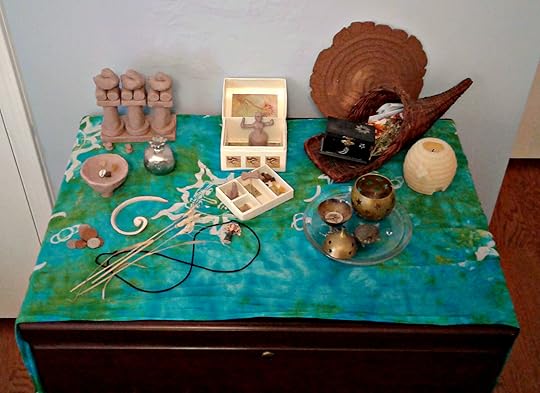 Modern Minoan Paganism is a partly reconstructed spiritual path, inspired by the archaeological remains of the Minoans of ancient Crete. But it doesn't have a set of strict rules to follow. Instead, it has general guidelines but encourages each practitioner to develop a personal relationship with the gods and goddesses of the Minoan pantheon so they can be the guides. In other words, Modern Minoan Paganism is a spirit-led path. To find out more, have a look at my latest post over on the Minoan Path blog:Modern Minoan Paganism: Is there a rule book?In the name of the bee,And of the butterfly,And of the breeze, amen.
Modern Minoan Paganism is a partly reconstructed spiritual path, inspired by the archaeological remains of the Minoans of ancient Crete. But it doesn't have a set of strict rules to follow. Instead, it has general guidelines but encourages each practitioner to develop a personal relationship with the gods and goddesses of the Minoan pantheon so they can be the guides. In other words, Modern Minoan Paganism is a spirit-led path. To find out more, have a look at my latest post over on the Minoan Path blog:Modern Minoan Paganism: Is there a rule book?In the name of the bee,And of the butterfly,And of the breeze, amen.
Published on June 07, 2017 04:28
May 31, 2017
Book Review: Pagan Portals Merlin
 I've been fascinated by the figure of Merlin for years and have read every book about him that I could get my hands on, but it wasn't until I read Pagan Portals Merlin: Once and Future Wizard by Elen Sentier that I felt like I really knew him. This isn't the usual Merlin book: There are no long diatribes about medieval writers or Iron Age British History (believe me, there's enough of that out there already). Instead, the author takes the reader along on a magical journey of discovery, a voyage through her own personal relationship with this mythical figure.Sentier practices Native British Shamanism, so it's not surprising that she emphasizes the shamanic and Otherworldly aspects of Merlin. In addition to the usual information about Merlin's place in the Arthurian legends, the author also addresses his character in other stories that I find equally fascinating: Myrddin Wyllt, the wild seer of the Caledonian forest, Custennin the Lord of the Beasts, the Horned One (the stag of seven tines Graves fans will be familiar with). Sentier also undertakes an examination of Merlin's place in the Vortigern story and his symbolism as the Fatherless Child, and draws the reader into a journey to Merlin's birthplaces (yes, plural) and an adventure in the Breton forest of Broceliande. I especially appreciated the fact that there's an entire chapter dedicated to Vivien/Nimue, an important part of Merlin's story who is usually either minimized or demonized, as if she doesn't matter or shouldn't be taken seriously.Merlin emerges as a liminal character, a shapeshifting nature spirit and wild man who is as old as Britain, as old as Brittany, far older than any of the stories we still tell about him. He also becomes engagingly personal in this book, as Sentier shares her encounters with him in various locations she visited. He's no longer a distant mythical figure but a vital aspect of the present-day mythos and magic of his part of the world, one with whom the reader can have a direct relationship if they wish. And certainly, after reading this lovely book, many people will want to.
I've been fascinated by the figure of Merlin for years and have read every book about him that I could get my hands on, but it wasn't until I read Pagan Portals Merlin: Once and Future Wizard by Elen Sentier that I felt like I really knew him. This isn't the usual Merlin book: There are no long diatribes about medieval writers or Iron Age British History (believe me, there's enough of that out there already). Instead, the author takes the reader along on a magical journey of discovery, a voyage through her own personal relationship with this mythical figure.Sentier practices Native British Shamanism, so it's not surprising that she emphasizes the shamanic and Otherworldly aspects of Merlin. In addition to the usual information about Merlin's place in the Arthurian legends, the author also addresses his character in other stories that I find equally fascinating: Myrddin Wyllt, the wild seer of the Caledonian forest, Custennin the Lord of the Beasts, the Horned One (the stag of seven tines Graves fans will be familiar with). Sentier also undertakes an examination of Merlin's place in the Vortigern story and his symbolism as the Fatherless Child, and draws the reader into a journey to Merlin's birthplaces (yes, plural) and an adventure in the Breton forest of Broceliande. I especially appreciated the fact that there's an entire chapter dedicated to Vivien/Nimue, an important part of Merlin's story who is usually either minimized or demonized, as if she doesn't matter or shouldn't be taken seriously.Merlin emerges as a liminal character, a shapeshifting nature spirit and wild man who is as old as Britain, as old as Brittany, far older than any of the stories we still tell about him. He also becomes engagingly personal in this book, as Sentier shares her encounters with him in various locations she visited. He's no longer a distant mythical figure but a vital aspect of the present-day mythos and magic of his part of the world, one with whom the reader can have a direct relationship if they wish. And certainly, after reading this lovely book, many people will want to.
Published on May 31, 2017 04:49
May 24, 2017
Minoan Shields: Shamanic Tool?
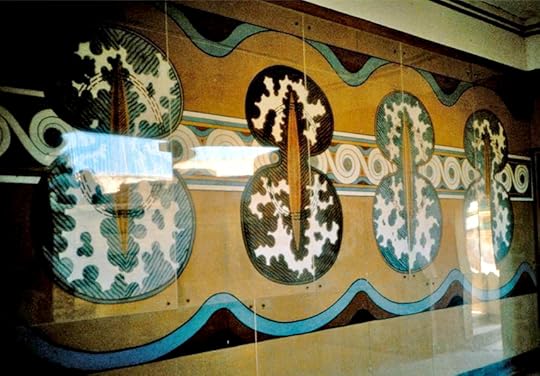 Today on theMinoan Path blog, I'm considering some possibilities for the intriguing figure-eight shields found in Minoan art. What if they're not just part of a warrior's accoutrements? What if they're also a tool for the shamanic priesthood of Dionysus?Minoan Shields: Shamanic Tool of the Kouretes?To join the discussion about Modern Minoan Paganism, head on over to our welcoming community atAriadne's Tribeon Facebook.In the name of the bee,And of the butterfly,And of the breeze, amen.
Today on theMinoan Path blog, I'm considering some possibilities for the intriguing figure-eight shields found in Minoan art. What if they're not just part of a warrior's accoutrements? What if they're also a tool for the shamanic priesthood of Dionysus?Minoan Shields: Shamanic Tool of the Kouretes?To join the discussion about Modern Minoan Paganism, head on over to our welcoming community atAriadne's Tribeon Facebook.In the name of the bee,And of the butterfly,And of the breeze, amen.
Published on May 24, 2017 05:24
May 17, 2017
Book Review: The Double Goddess
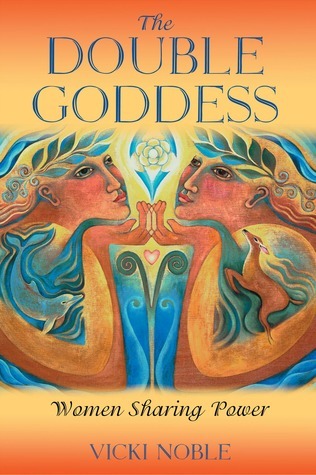 I wasn't sure what to expect when I first picked up this book and began to read, but I ended up enjoying it more than I expected. The author's main thrust is the re-identification of the huge number of doubled or twinned female figurines and images that span centuries of ancient art and are found all over the world. These "double goddess" images have long labeled as part of a "fertility cult," that dismissive label archaeologists slap on so many pieces of ancient spirituality when they threaten to put the Divine Feminine in the spotlight. But what Vicki Noble suggests in this book, and I think her argument is a reasonably convincing one, is that these works of art reflect not only a concept of a twinned goddess but also a real-world sharing of power between women in leadership positions in some ancient societies. Whether this doubled role meant two leaders sharing the office at the same time, or something more like the Chief and the Tanist, or a secular leader and a religious one (or, to take a modern example, the CEO and the COO), is unclear. Still, it's an interesting proposition, and one that takes us into the realm of cooperation ahead of competition, something this world could certainly use more of.I will admit that I have some trouble with Noble's view of the pre-patriarchal world as somehow magically peaceful and Golden Age-y. The archaeological evidence is pretty clear that, from at least the Neolithic onward, there has always been a certain amount of violence in human societies, though it took some time for us to build up to the vast scale of the wars of recent centuries (not exactly our greatest achievement). But I do think Noble is on to something about the way leadership worked in matrifocal cultures, with human institutions reflecting the mythology and vice versa. This is a subject that could do with more exploration, to be sure. And I very much enjoyed the way she links the Mediterranean world with the areas farther east via the Silk Road, a connection many archaeologists and historians seem to miss in spite of the overwhelming evidence of contact going back many, many centuries.The book includes extensive illustrations of the double goddesses from the archaeological record, which I found fascinating. This isn't a theory built on a couple of pieces in a back corner of a museum somewhere. There are hundreds, possibly thousands of these doubled female images in the art going back millennia. I find it hard to believe that such a widespread and ancient symbol set has no meaning, and this book helped me realize the extent to which archaeologists and historians have selectively ignored these figures because of what they might represent. All in all, this is a fascinating read, well researched and heavily documented. Whether or not you end up agreeing with Noble's ideas, you'll come away having acquainted yourself with a segment of our history that is often glossed over or dismissed but that deserves a great deal more attention.
I wasn't sure what to expect when I first picked up this book and began to read, but I ended up enjoying it more than I expected. The author's main thrust is the re-identification of the huge number of doubled or twinned female figurines and images that span centuries of ancient art and are found all over the world. These "double goddess" images have long labeled as part of a "fertility cult," that dismissive label archaeologists slap on so many pieces of ancient spirituality when they threaten to put the Divine Feminine in the spotlight. But what Vicki Noble suggests in this book, and I think her argument is a reasonably convincing one, is that these works of art reflect not only a concept of a twinned goddess but also a real-world sharing of power between women in leadership positions in some ancient societies. Whether this doubled role meant two leaders sharing the office at the same time, or something more like the Chief and the Tanist, or a secular leader and a religious one (or, to take a modern example, the CEO and the COO), is unclear. Still, it's an interesting proposition, and one that takes us into the realm of cooperation ahead of competition, something this world could certainly use more of.I will admit that I have some trouble with Noble's view of the pre-patriarchal world as somehow magically peaceful and Golden Age-y. The archaeological evidence is pretty clear that, from at least the Neolithic onward, there has always been a certain amount of violence in human societies, though it took some time for us to build up to the vast scale of the wars of recent centuries (not exactly our greatest achievement). But I do think Noble is on to something about the way leadership worked in matrifocal cultures, with human institutions reflecting the mythology and vice versa. This is a subject that could do with more exploration, to be sure. And I very much enjoyed the way she links the Mediterranean world with the areas farther east via the Silk Road, a connection many archaeologists and historians seem to miss in spite of the overwhelming evidence of contact going back many, many centuries.The book includes extensive illustrations of the double goddesses from the archaeological record, which I found fascinating. This isn't a theory built on a couple of pieces in a back corner of a museum somewhere. There are hundreds, possibly thousands of these doubled female images in the art going back millennia. I find it hard to believe that such a widespread and ancient symbol set has no meaning, and this book helped me realize the extent to which archaeologists and historians have selectively ignored these figures because of what they might represent. All in all, this is a fascinating read, well researched and heavily documented. Whether or not you end up agreeing with Noble's ideas, you'll come away having acquainted yourself with a segment of our history that is often glossed over or dismissed but that deserves a great deal more attention.
Published on May 17, 2017 04:43
May 10, 2017
Dividing the Minoan World
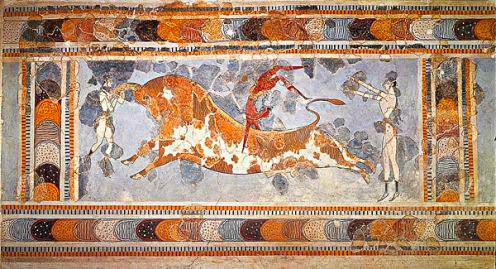 The world is so big, we like to divide it up into manageable segments, sections we can get our heads around and maybe understand. The Minoans were no different from anyone else in this regard. Today on theMinoan Path blog, I explore a few of the ways the Minoans appear to have divided up their world:Dividing the Minoan WorldTo join the conversation about Modern Minoan Paganism, head on over to our welcoming community atAriadne's Tribeon Facebook.In the name of the bee,And of the butterfly,And of the breeze, amen.
The world is so big, we like to divide it up into manageable segments, sections we can get our heads around and maybe understand. The Minoans were no different from anyone else in this regard. Today on theMinoan Path blog, I explore a few of the ways the Minoans appear to have divided up their world:Dividing the Minoan WorldTo join the conversation about Modern Minoan Paganism, head on over to our welcoming community atAriadne's Tribeon Facebook.In the name of the bee,And of the butterfly,And of the breeze, amen.
Published on May 10, 2017 04:55
May 3, 2017
Sacred Saffron: A bit of autumn magic
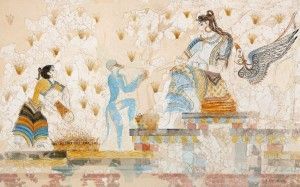 Saffron was sacred to the ancient Minoans. It's a very special flower: The fact that it blooms in the autumn sets it apart from the other flowering plants. Today on the Minoan Path Blog, I share how it figures in Minoan mythology and which goddess it's sacred to:Sacred Saffron: A bit of autumn magicIf you'd like to join the conversation about Modern Minoan Paganism, head on over toAriadne's Tribe, our welcoming community on Facebook.In the name of the bee,And of the butterfly,And of the breeze, amen.
Saffron was sacred to the ancient Minoans. It's a very special flower: The fact that it blooms in the autumn sets it apart from the other flowering plants. Today on the Minoan Path Blog, I share how it figures in Minoan mythology and which goddess it's sacred to:Sacred Saffron: A bit of autumn magicIf you'd like to join the conversation about Modern Minoan Paganism, head on over toAriadne's Tribe, our welcoming community on Facebook.In the name of the bee,And of the butterfly,And of the breeze, amen.
Published on May 03, 2017 04:59
April 26, 2017
Book Review: People of the Sea
 Most historical fiction revolves around well-known figures in well-documented times.People of the Seabreaks that mold, and several others, as it takes the reader along on a poetic journey during the Bronze Age collapse, also known as the Greek Dark Ages, in the eastern Mediterranean and the Levant. This is a tale of Deucalion and Pyrrha, Ariadne and Theseus, not the mythological characters but flesh-and-blood people fighting to save their way of life during a horribly tumultuous time.We know very little, in terms of historical "hard evidence," about the Sea Peoples and the events that occurred during the few centuries that ended the Bronze Age in the Aegean, the Levant, and adjacent areas. Dempsey has taken that slim framework and filled in the blanks to create a deeply textured tale that tugs at the heartstrings one moment, and twists a dagger in that same heart the next. His choice of Deucalion, the Pelasgian version of Noah and Utnapishtim, as the sailor-trader who narrates this tale of upheaval and crisis, is more than appropriate. But it's a flood of a different sort, the backstabbings and abuses and opportunistic moves that accompany any time of collapse in human history, that he rides out in order to survive.This is not a quick read or an easy one. Dempsey's style is poetic and dense and breathtakingly wide-ranging, as if Robert Graves had come back from the grave to write a Michener novel. Reading this book is hard work, and some prior knowledge of the history and mythology of the era is helpful, almost a must (either that, or plan to look up a lot of names and places). The author has taken quite a few liberties with the bits we do know about the timeline of the Bronze Age Mediterranean, but this isn't a history book. It's a mythic tale that speaks as much to archetypes and the nature of the human psyche as it does to a particular period of history. It's a story of how some people will always take advantage of the misfortunes of others. It's a story of survival and determination and undying love. If you ask me, those are things worth reading about.
Most historical fiction revolves around well-known figures in well-documented times.People of the Seabreaks that mold, and several others, as it takes the reader along on a poetic journey during the Bronze Age collapse, also known as the Greek Dark Ages, in the eastern Mediterranean and the Levant. This is a tale of Deucalion and Pyrrha, Ariadne and Theseus, not the mythological characters but flesh-and-blood people fighting to save their way of life during a horribly tumultuous time.We know very little, in terms of historical "hard evidence," about the Sea Peoples and the events that occurred during the few centuries that ended the Bronze Age in the Aegean, the Levant, and adjacent areas. Dempsey has taken that slim framework and filled in the blanks to create a deeply textured tale that tugs at the heartstrings one moment, and twists a dagger in that same heart the next. His choice of Deucalion, the Pelasgian version of Noah and Utnapishtim, as the sailor-trader who narrates this tale of upheaval and crisis, is more than appropriate. But it's a flood of a different sort, the backstabbings and abuses and opportunistic moves that accompany any time of collapse in human history, that he rides out in order to survive.This is not a quick read or an easy one. Dempsey's style is poetic and dense and breathtakingly wide-ranging, as if Robert Graves had come back from the grave to write a Michener novel. Reading this book is hard work, and some prior knowledge of the history and mythology of the era is helpful, almost a must (either that, or plan to look up a lot of names and places). The author has taken quite a few liberties with the bits we do know about the timeline of the Bronze Age Mediterranean, but this isn't a history book. It's a mythic tale that speaks as much to archetypes and the nature of the human psyche as it does to a particular period of history. It's a story of how some people will always take advantage of the misfortunes of others. It's a story of survival and determination and undying love. If you ask me, those are things worth reading about.
Published on April 26, 2017 04:58
April 19, 2017
Offering to the Minoan Gods
 Offerings are a major part ofModern Minoan Paganism, but it's important to understand that each deity has offerings they like and offerings you shouldn't give them. The gods have their own individual tastes just like we do. Today on theMinoan Path blogI've shared a few "safe bet" offerings for many of the Minoan gods and goddesses:Offering to the Minoan GodsDo you make offerings to the deities you have relationships with?In the name of the bee,And of the butterfly,And of the breeze, amen.
Offerings are a major part ofModern Minoan Paganism, but it's important to understand that each deity has offerings they like and offerings you shouldn't give them. The gods have their own individual tastes just like we do. Today on theMinoan Path blogI've shared a few "safe bet" offerings for many of the Minoan gods and goddesses:Offering to the Minoan GodsDo you make offerings to the deities you have relationships with?In the name of the bee,And of the butterfly,And of the breeze, amen.
Published on April 19, 2017 05:42
April 12, 2017
Book Review: The Knowing
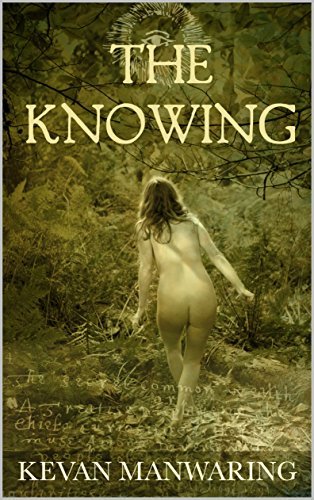 The KnowingbyKevan Manwaringis slotted into the Paranormal & Urban Fantasy category on Amazon, but I think it has a much wider appeal than that. This tale manages to span centuries, continents, and realms while remaining eminently readable. On the surface it's the story of a woman coming to terms with her inherited Second Sight ability and the losses she has faced in life. But beneath that level lurks the age-old folklore of Scotland and the Appalachians, sister lands, and the possibility that there's more to existence than just those things our scientific instruments can measure.Manwaring's novel feels true in the way that certain stories do, as if the author hadn't written it so much as discovered it, already complete and ready to be revealed. I always enjoy any book that portrays the Fey as the crafty, dangerous being they are; no sparkly Victorian winged flowers here. I won't give away the long series of twists, turns, and surprises this tale offers, except to say that humans have always had a tendency to believe what they want to about other kinds of beings, and that tends to end badly much of the time. Thankfully, the heroine of this story learns better very quickly.The author is a talented British storyteller; bits of British speech and idiom creep in throughout the tale even though the main characters (the human ones, anyway) are American. Fortunately, this just adds to the overall charm of the work.Like the Fey and the plot, the e-book itself is full of cunning entanglements. The author has managed to put together a multi-layered reading experience that drifts between times and places but still flows and feels cohesive. Though Manwaring offers the reader the option of plowing through the main narrative first and then reading the secondary sections, I strongly recommend following each embedded link as you come to it, then returning to the larger story where you left off. You'll be richly rewarded.
The KnowingbyKevan Manwaringis slotted into the Paranormal & Urban Fantasy category on Amazon, but I think it has a much wider appeal than that. This tale manages to span centuries, continents, and realms while remaining eminently readable. On the surface it's the story of a woman coming to terms with her inherited Second Sight ability and the losses she has faced in life. But beneath that level lurks the age-old folklore of Scotland and the Appalachians, sister lands, and the possibility that there's more to existence than just those things our scientific instruments can measure.Manwaring's novel feels true in the way that certain stories do, as if the author hadn't written it so much as discovered it, already complete and ready to be revealed. I always enjoy any book that portrays the Fey as the crafty, dangerous being they are; no sparkly Victorian winged flowers here. I won't give away the long series of twists, turns, and surprises this tale offers, except to say that humans have always had a tendency to believe what they want to about other kinds of beings, and that tends to end badly much of the time. Thankfully, the heroine of this story learns better very quickly.The author is a talented British storyteller; bits of British speech and idiom creep in throughout the tale even though the main characters (the human ones, anyway) are American. Fortunately, this just adds to the overall charm of the work.Like the Fey and the plot, the e-book itself is full of cunning entanglements. The author has managed to put together a multi-layered reading experience that drifts between times and places but still flows and feels cohesive. Though Manwaring offers the reader the option of plowing through the main narrative first and then reading the secondary sections, I strongly recommend following each embedded link as you come to it, then returning to the larger story where you left off. You'll be richly rewarded.
Published on April 12, 2017 05:13



